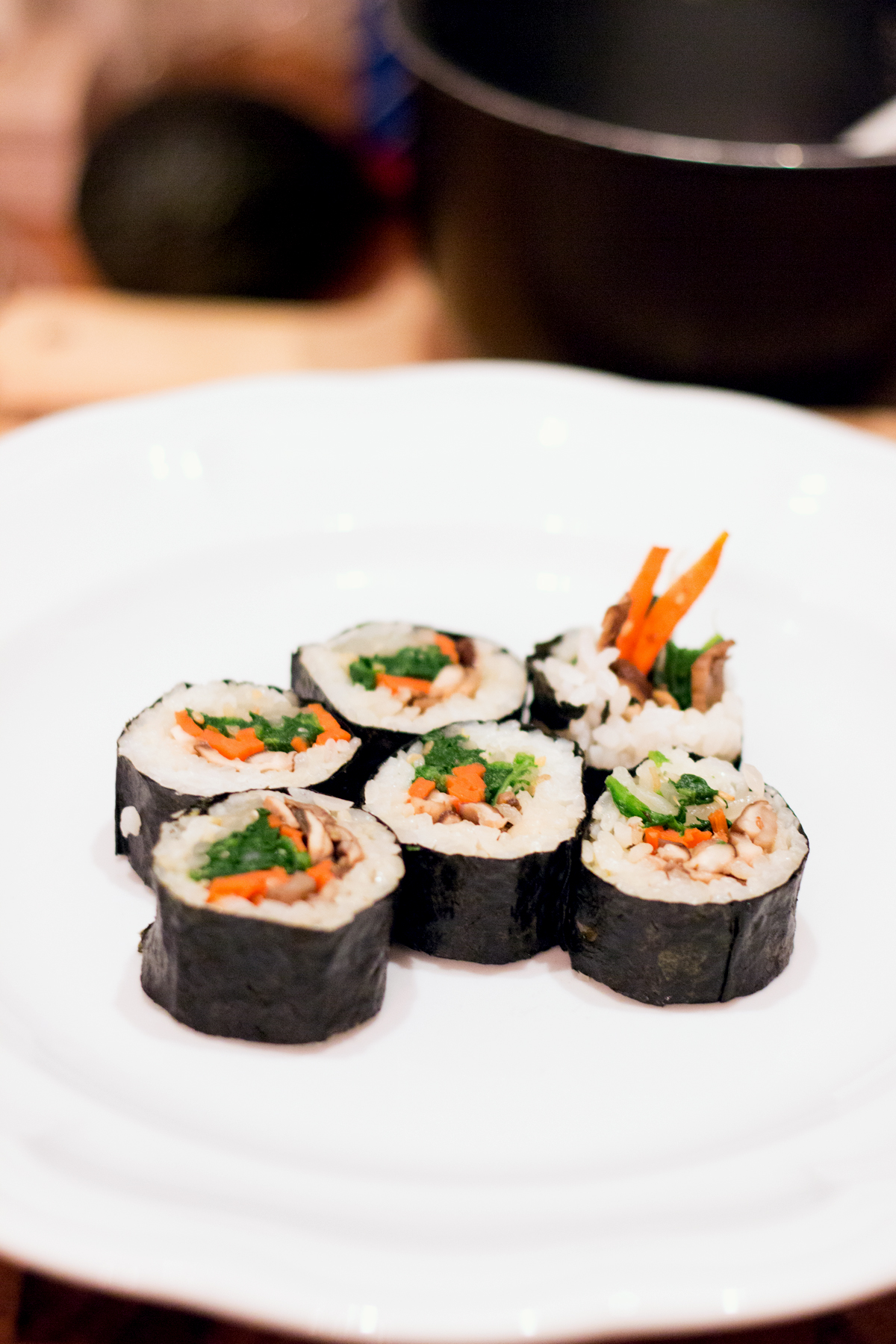Giving bibimbap the sushi treatment was my weekend stroke of genius. Bite-size deployment of bibimbap? Yes, please.
Like many Southeast Asian dishes, these sushi rolls involves a lot of elements prepared separately that all comes together at the end. But, I promise that each component cooks in 2-3 minutes and each of the sauces (yes, plural) whips together in minutes. So, lots of active cooking time, but it all comes together quickly and is totally worth it. Because, this is some eye-closing delicious stuff.
Ok. Here we go.
Bibimbap Sushi Rolls
For the sushi rolls:
5 pieces of sushi nori
2 cups of dry sushi rice (then prepared — I used a rice cooker)
A bamboo sushi rolling mat
For the components:
1 bunch of spinach, cleaned and stems trimmed off
1 bag of bean sprouts, cleaned
1/4 lb of mushrooms, sliced (preferably shiitake, but regular brown mushrooms will do)
1 carrot, julienned or thinly sliced
1 tsp salt
2 or 3 pieces of kimchi, thinly sliced
Olive oil for sauteing
Sauce for spinach and bean sprouts:
2 tsp scallions, thinly sliced or chopped
1 tsp garlic, minced
2 tsp toasted sesame seeds (you can quickly toast them in the same pan you’re using for the carrots)
1/2 tsp salt
2 tbsp sesame oil
Bi bim bap sauce: (optional, you can just use soy sauce as a dipping sauce too)
2 tbsp gochujang
1 tbsp sesame oil
1/2 tbsp sugar
1 tbsp water
1 tbsp toasted sesame seeds
1 tsp vinegar
1 tsp garlic, minced
First, set your sushi rice to cook in your rice cooker or your preferred method.
Put a medium skillet on medium heat with some of the olive oil (you can toast the sesame seeds now, and remove them when browned). Set a saucepan on medium heat and boil some water, and add 1 tsp salt to the water.
When your skillet is hot enough, toss in the carrots and 1/2 tsp salt. Sautee for 2 or 3 minutes or until they look softened. Remove carrots from pan. Add in mushrooms and 1/2 tsp salt and sautee until mushrooms are browned, another 2-3 minutes. Remove mushrooms from skillet.
With water boiling in your saucepan, add in trimmed and cleaned spinach. Boil spinach for 30 seconds. Remove spinach from water using tongs and put in strainer (don’t pour the water out, you want to save the boiling water for the bean sprouts). Run cold water over spinach, then press out water.
Add bean sprouts to same boiling water. Boil them for 1-2 minutes, then put them in a strainer and run under cold water. Put the bean sprouts in a bowl.
Take the boiled spinach and put it on a cutting board and chop finely. Put chopped spinach in a bowl.
Mix the spinach and bean sprout sauce. Pour half of the sauce over the spinach and toss. Pour the other half over the bean sprouts and toss.
Mix the bi bim bap sauce if you’re planning on using it.
You’re now ready to start making the sushi rolls!
First, lay a dried piece of nori over your sushi mat. (Sushi mat should be shiny side up) Fill a small bowl with water. Using your fingers, wet the nori with water. Next, put about a cup of cooked sushi rice onto the bottom half of your nori and spread out. (Use the bowl of water at this point whenever your fingers get sticky.)
Next, lay down a strip of carrots on top of the rice. Then, the mushrooms, spinach, bean sprouts, and kimchi. Raise the edge of your sushi mat and begin rolling, using the tip of your fingers to tuck in the vegetables as you roll. When you have a circle of rice, raise the top of the sushi mat to bring the remaining nori over the top of your roll. Release the sushi mat from both sides, and roll the sushi roll into the sushi mat and squeeze the roll. Unroll the sushi mat and put the sushi roll onto a separate cutting board.
Make the remaining 4-5 sushi rolls.
Now, to slice. You’ll need a very sharp knife. Use a wet paper towel to wipe down the surface of your knife and slice the sushi roll in half. Use the wet paper towel again to clean off any rice and slice the halved slices in half again, then half again. Before each slice, it might help to keep cleaning off/wetting your knife to get a nice cut.
Rolling sushi is pretty difficult, and I’m sure I’m doing it completely wrong according to real chefs. But, in the end, all the flavors are there and that is key, no matter what your rolls look like.







